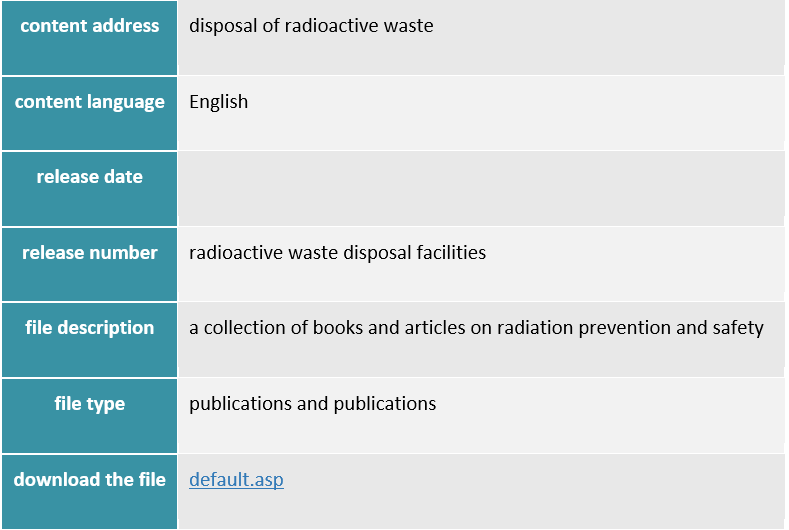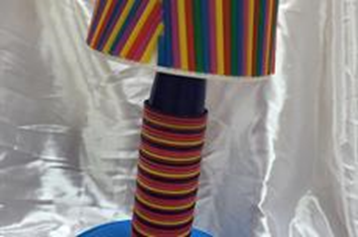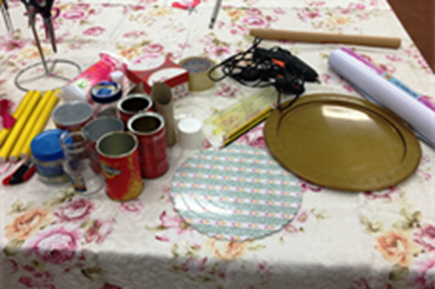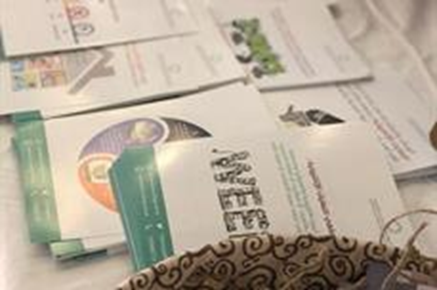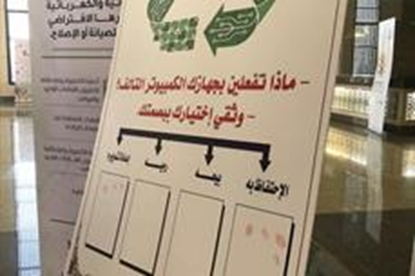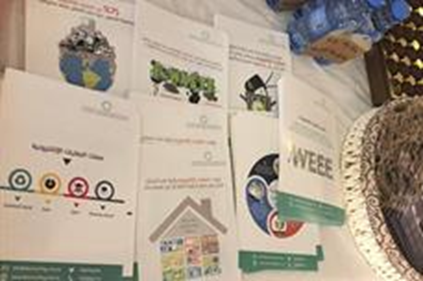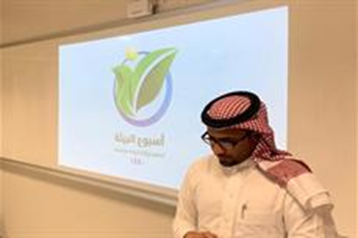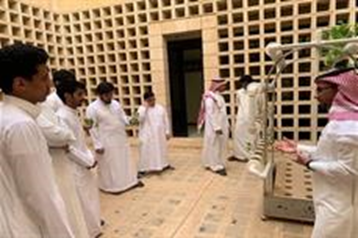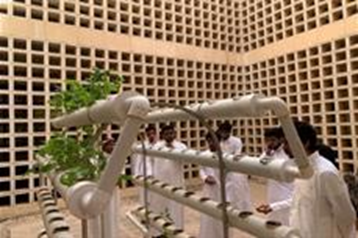Introduction
Sustainable Development Goal 12 (SDG 12 or Global Goal 12) is about "responsible consumption and production". It is one of the 17 Sustainable Development Goals established by the United Nations in 2015. The official wording of SDG 12 is "To ensure sustainable consumption and production patterns".
Worldwide consumption and production — a driving force of the global economy — rest on the use of the natural environment and resources in a way that continues to have destructive impacts on the planet. Economic and social progress over the last century has been accompanied by environmental degradation that is endangering the very systems on which our future development — indeed, our very survival — depends.
The Kingdom of Saudi Arabia has witnessed significant growth in several areas, the most important of which is population growth and growth in the industrial and agricultural sectors. This creates difficulties and challenges in the process of waste management of all kinds. Waste, recycling, To the Kingdom, in addition to creating jobs and reducing the emissions of buried gases from landfills and converting them into energy.
The Kingdom of Saudi Arabia's Responsible Production and Consumption Initiatives
Establishment of Saudi Paper and Waste Recycling Company.
Integrated Waste Management Initiative in Jubail Industrial City.
Comprehensive strategy for waste management in Riyadh.
Development of municipal waste management systems.
The initiative of limit food waste in cooperation with the Itaam Charitable Society.
IMAMU University contributes to goal 12 by developing a Single-Use Plastics Policy in order to reduce plastic consumption in addition to making students aware of preserving nature and the planet. In addition to this, the university has participated in events, conferences and workshops that are oriented towards achieving zero waste and resource recycling.
The College of Computer and Information Sciences at Imam Muhammad bin Saud Islamic University launched the (Giving with Your Device) initiative today, Wednesday 30/8/2023.
The Dean of the College, Dr. Talal Al-Balawi, stressed that this initiative targets the college's employees, including faculty members, administrators, and male and female students, as Dr. Al-Balawi pointed out that this initiative came to make full use of computers by recycling them, to reduce material waste and rationalize consumption, and the initiative also seeks to raise the level of awareness of individuals, enhance social responsibility, and enable people with special circumstances from college students to obtain devices that suit their own needs, by donating a device or contribute to the inspection and evaluation of devices and configure them for a new user.
The launch of the initiative included a visual presentation explaining the initiative and explaining its objectives.
The inauguration was attended by the Vice Dean of the College, Dr. Maria Al-Otaibi, the Social Worker from the Psychological and Social Counseling Unit at the College, Dr. Nahed Al-Raisi, and the Head of the College's Laboratories, Ms. Al-Hanouf Al-Arini, along with the college's leaders and employees.
The deanship of student affairs, represented by the student affairs agency, was organized under the supervision of the department of activities and student clubs workshop entitled (recycling materials) in the building of the slippers. from Sunday, april 21, 1437 to Monday
The workshop aims to develop the creative and artistic aspect by recycling materials and benefit from them by making different artistic forms.
The deanship of student affairs, represented by the deanship agency for student affairs under the supervision of the department of student programs and activities, organized a technical workshop entitled synthesis of materials from tuesday, july 21, 1438 ah to thursday, july 23, 1438 h. 323.
The workshop aims to educate students about the importance of preserving the environment and recycling consumed materials and materials, and how to synthesize materials from the environment to produce reusable works of art.
In celebration of this day, the Economics Club at the Faculty of Economics and Administrative Sciences organized the World Green Economy Day event in partnership with the National Environment Recycling Company in the fields of e-waste, on Monday morning, 15/2/1441 AH, which is located in the main lobby of Building (322).
The four-day event aims to educate students about the importance of disposing of e-waste in an environmentally friendly way, and its contribution to raising the economy by producing a clean energy source through the recycling of those wastes, and the recycling corner of the private environment contained fires and information explaining the idea of the company, which is important in recycling e-waste in an environmentally friendly way, in addition to placing containers to collect e-waste to be recycled and produce renewable energy from it after the end of the event.
Within the same event, the Environment Club was inaugurated at the Deanship of Student Affairs for Female Students' Affairs, through which the vision, mission and objectives of the club were clarified to seek a healthy environment free of pollution in a conscious society, improve human behavior in the use of harmful objects to the environment, and to educate students about the damage of environmental pollution.
The event focused entirely on encouraging the adoption of sound environmental behavior to drive sustainable development.
The department of physics at imam mohammed bin saud islamic university organized a cultural activity entitled "e-waste in cooperation with daz saudi factory and the civil environment recycling company to support the activity with information and flyers on thursday, february 14, 1440 ah, november 22, 2018 in panorama building 323 from 9 to 11 p.m. the campaign was supervised by a. marvat al-zamia, coordinator of the department of physics, faculty member and follow-up of a. ahlam al-hawiti, activity supervisor and faculty member, and the coordination of a. saji al-qusayr with a group of students from the faculty of science.
Electronic and electrical waste is one of the most threatened wastes for the environment and human life because it contains more than 1,000 different substances, mostly toxic components. when these devices are disposed of randomly, their components seep from toxic elements into natural resources from water, water, water, soil, etc.
From this point of view, the students of the electronics laboratory from the department of physics carried out an awareness activity and an introductory corner aimed at raising awareness of the dangers of e-waste.
This campaign aims to introduce electronic waste and raise awareness of its problems and damage by identifying the environmental impacts of mismanagement of electronic waste.
At the end of the campaign, h.e. department coordinator a. marvat al-zamia thanked the officials and organizers of this activity, as well as to his excellency the dean of the faculty, dr. mohammed al issa, and his excellency the head of the department of physics, dr. ahmed al-qaoud, and his excellency the faculty of science undersecretary dr. abeer al-nahdi for supporting such important scientific activities in promoting a positive and sound view of electronic waste and recycling methods.
The students expressed their happiness and gratitude to the faculty of science and the department of physics, which provided them with the opportunity to participate and organize.
It is worth mentioning that the department of physics offers great thanks, appreciation and great gratitude to a. saji al qusay and the team for their fruitful efforts in improving the efficiency of dealing with electronic waste, asking them to reconcile and pay.
Thanks to h.e. secretary of the department of physics a. hana al-jumai for her concrete efforts in coordinating such successful initiatives.
To view previous scientific visits to the department of physics over the past year: link
To view the previous scientific activities of the department of physics over the past year: link
Within the framework of the celebration of the World Environment Week, the Department of Biology, represented by a number of faculty members, namely: Dr. Hassan Redini, Head of the Department, Prof. Fawzi Hawala, Undersecretary of the Department, and Dr. Mohammed Al-Zahrani, met with a number of students of the Department on Wednesday, 20 Rajab 1440 corresponding to March 27, 2019.
At the beginning of the meeting, the Head of the Department welcomed the students and thanked them for their presence and interest, and then made a presentation that included the introduction of the World Environment Week and its objectives. This week is an essential mechanism for the United Nations to promote global awareness and action for the environment, and this day has been growing over the years to become a global platform for public awareness celebrated by stakeholders in more than 100 countries on a large scale, as well as a day to celebrate people who do positive work towards the environment, and to sharpen individual actions to form collective forces that generate a steady positive impact on the planet. This year's World Environment Day theme is about plastics under the theme "Overcoming Plastic Pollution".
The Kingdom of Saudi Arabia has a Ministry of Environment, the Ministry of Environment, Water and Agriculture.
Among the objectives of this week are:
Raising awareness of the importance of preserving the environment.
Activating the role of government and private institutions and charities in preserving the environment
Raising the responsibility of individuals towards the environment and the impact on them.
Contribute to the reduction of environmental pollution.
In conclusion, the Head of the Department renewed his thanks to the students of the Department for their interest and motivation to take greater care of the environment and spread the culture of preserving it in order to ensure its sustainability and enjoyment of its aesthetics.
American chemists Paul Anastas and John Warner put forward in the book "Green Chemistry Theory and Practice" 12 principles that are conditions that must be met for chemistry to be "green." Among these principles is the need to adopt manufacturing methods that do not produce substances that are highly toxic to humans and other living organisms and to reduce chemical residues whose mass in some conventional manufacturing processes exceeds hundreds of times the size of the product itself.
For example, according to a 2003 study, making a single computer chip requires materials up to 630 times the size of the same chip, while cars require twice as much weight as different materials.
Another principle of green chemistry is to use renewable primary resources and reduce dependence on non-renewable resources such as oil, while ensuring that manufacturing processes are conducted at normal temperature and pressure to reduce energy consumption.
Manufactured chemicals must also be easily biodegradable by the influence of natural factors into compounds that are harmless to the environment to prevent these manufactured substances from becoming pollutants of the environment, as is the case with plastic products, whose accumulation as a result of their slow decomposition has led to serious environmental damage from which the oceans have not been spared, and represent a danger to living organisms whose effects extend over decades.
Applications
Applying the principles of green chemistry and with the aim of reducing waste production, depleting natural resources and maintaining a healthy environment, the researchers came up with the design of new manufacturing methods that respond to these conditions.
For example, finding a natural alternative to polymers extracted from oil products widely used to produce substances harmful to the environment and human health such as plastic bags, polysaccharides that can be extracted from potatoes, cereals and many plants, will enable these natural polymers to manufacture biodegradable materials without harming the environment.
To manufacture food colorants and flavorings, the researchers developed a new technique based on starch-derived glucose to replace the currently widely used chemicals that are not without risks to human health and whose manufacturing process generates a lot of contaminated substances.
Researchers in the field of green chemistry have invented new techniques to conduct chemical reactions, including the technique of using ultrasound in chemical manufacturing, and this technique works to achieve the principle of economy of atoms and stimulates the reaction to take place in a short time and have a high yield compared to traditional methods.
The technique of using carbon dioxide in a supercritical state – an intermediate state between liquids and gases – as a solvent is also one of the most promising techniques in the field of sustainable chemistry, and this technique allows to increase the yield of reactions, reduce the quantities of chemicals exploited in the chemical and textile industries, as well as reduce the natural resources consumed in these industries.
Nike recently announced its reliance on carbon dioxide in an above-critical state as a solvent in fabric dyeing operations at one of its factories in Taiwan, and the technology will provide large quantities of water estimated at 150 liters of water consumed to make a single shirt.
For their part, research centers are developing new scientific techniques that help to manufacture consumer products without harming the environment, and in the past decade many scientific journals specialized in the field of green chemistry have emerged to encourage researchers to produce scientific in this field.
However, the sometimes high cost of some of these technologies remains the main obstacle to the manufacture of alternative materials, at least at the current stage, but the issue of preserving natural resources and maintaining a clean environment has become a growing concern for both people and governments and will push for the adoption of these technologies in the future.
Will green chemistry succeed in repairing what industrial chemistry has corrupted for more than a century (citing Environmental News)?


